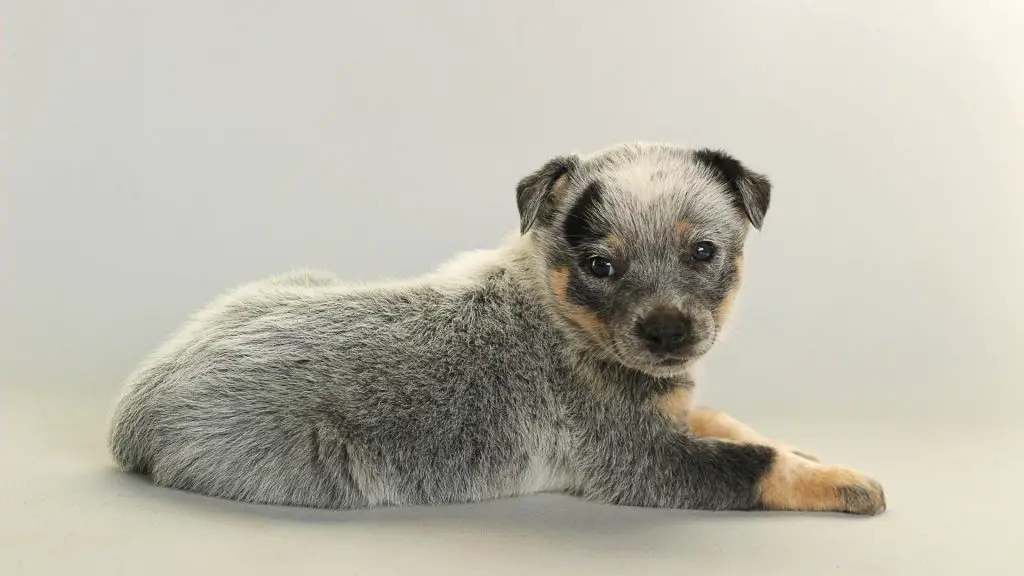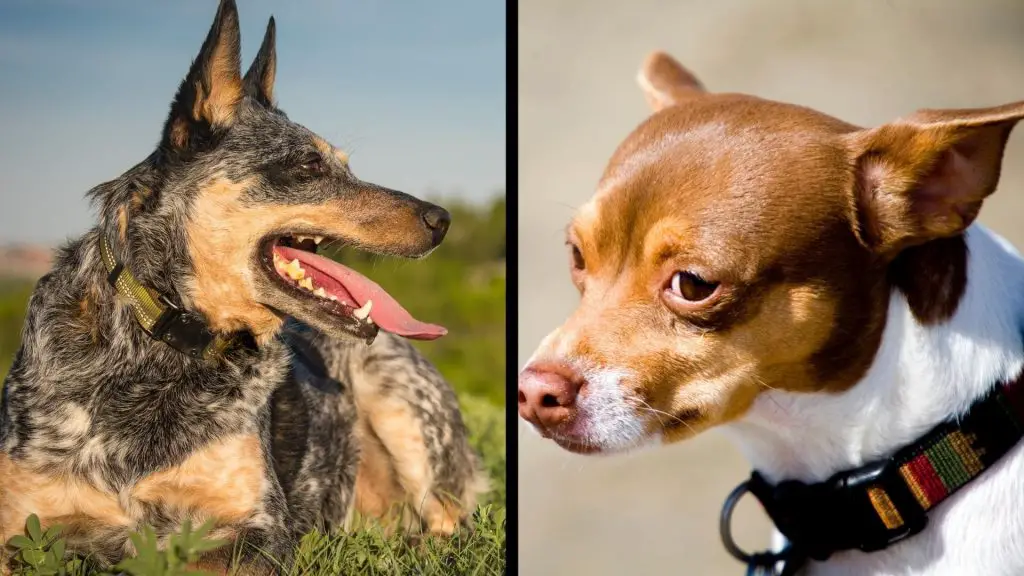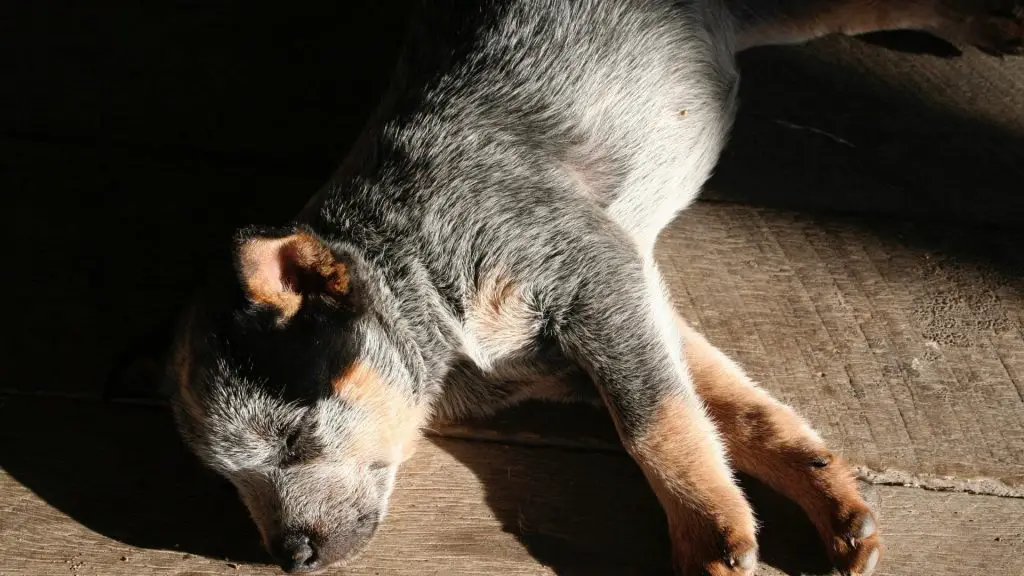Pawscessories is reader-supported. When you buy via links on our site, we may earn an affiliate commission at no cost to you.
Learn more.
Are you considering adding a Blue Heeler Rat Terrier mix to your family? These dogs are friendly, intelligent, and make great pets. This article will cover everything you need to know about the breed before making your decision. We’ll discuss their history, what they were bred for, their physical appearance and size, colors, temperament, and plenty of other frequently asked questions.
Table of Contents

What Is A Blue Heeler Rat Terrier Mix?
The Blue Heeler Rat Terrier mix is a cross between the Australian Cattle Dog (Blue Heeler) and the Rat Terrier. These dogs are also sometimes referred to as a Heeler Rat, Cattle Dog Rat Terrier mix, or a Texas heeler.
What Breeds Make A Cattledog Terrier?
The Australian Cattle Dog, also known as a Blue Heeler or Queensland Heeler, is a herding dog that was developed in Australia for cattle ranching. They are a cross between the Scottish blue merle Collie and Dingoes.
The Rat Terrier is a small terrier that was originally bred to kill rats in homes and warehouses. They are a mix of the English White Terrier, the Manchester Terrier, Fox Terrier, and Bull Terrier.
The Blue Heeler Rat Terrier mix is a cross between these two breeds.
History Of The Blue Heeler Rat Terrier Mix

The Blue Heeler Rat Terrier was first bred in the United States in the late 1990s and has become a popular choice for many families since then.
These dogs are intelligent and easy to train, making them great pets. They are also very loyal and make excellent watchdogs.
The Blue Heeler Rat Terrier is a relatively new breed, so little is known about their history. However, we do know they were bred for companionship and make great family pets.
Where Do Blue Heelers Come From?
More formally known as the Australian Cattle Dog, Blue Heelers were bred to help ranchers in Australia grow their beef industry in the early 1800s.
Blue Heelers came to be by fulfilling a need for a vigilant working dog while also being able to handle Australia’s extreme heat. The origins of Blue Heelers started with a breed called Smithfeilds. They were imported from Britain and unsuitable for the terrain, heat, and amount of work that cattle ranchers needed from their herding dogs.
This began the process of developing Blue Heelers and started with breeding the Smithfeilds with Dingoes (dogs native to Australia) and Scottish Highland Collies. The aim was to breed a dog that was intelligent, hard-working and could handle the working conditions in Australia.
Later, people started breeding only Dingoes and Collies together, and the final addition to the Australian Cattle Dog was breeding Dalmations with the Dingo/Collie dog.
This perfected the combination of hard-working, loyalty, gentleness, and protectiveness that cattle ranchers needed from a herding dog. It’s also the genetic makeup of the Australian Cattle Dog (Blue Heeler) that we know today.
The breed was added to AKC in 1980.
Where Do Rat Terriers Come From?
Rat Terriers are an American breed that was bred from Fox Terriers, Old English White Terriers, Bull Terriers, and Machester Terriers. There may be more mixed in with them, but the others are lesser-known.
Rat Terriers were bred to help with the rat problem many farms had at the time. Without Rat Terriers helping control the vermin problem farm owners had, it could have resulted in them not having enough food to last through winter.
In the Mid Western states, Rat Terriers were bred with Whippets and Grey Hounds between the 1910s and 1930s to make them quicker and better able to do their job catching rodents.
In other regions, Rat Terriers were bred with Beagles to improve their loyalty and pack orientation. This meant they had the speed of a Whippet with the strong sense of companionship and sense of smell from Beagles.
Until the 1940s, Rat Terriers were common practice on many farms to help keep rodent populations at bay. At this point, many farms discovered and started using poisons to control rodent populations making Rat Terriers less popular.
A select few breeds kept the breed around until the 1970s when they regained popularity and found their place in many homes across America.
What Was The Blue Heeler Rat Terrier Mix Bred For?
Many increasingly popular mixed breeds are bred primarily for their unique appearance. While certain breeds are still used as working dogs on farms, there’s less need for new breeds to be genetically designed for working purposes.
For the most part, designer mixed breeds today are established to create unique appearances and temperaments to give owners a unique pet. Also, one that has a temperament more congruent with their lifestyle.
So as of now, Blue Heeler Rat Terriers are bred because of people’s love for t e two breeds and desire to have a combination of the two.
Blue Heeler Rat Terrier Appearance & Traits

The Blue Heeler Rat Terrier is a medium-sized dog with a short, dense coat. They have a square head, pointed ears, and a long, tapered muzzle. The breed is known for its athletic build and webbed feet, making them excellent swimmers.
Their tail is usually docked to about half its original length.
Size (Weight & Height)
The Blue Heeler Rat Terrier is a medium-sized dog. They typically weigh between 35 and 50 pounds and stand 18 to 22 inches tall at the shoulder.
Coat Colors & Texture
The Blue Heeler Rat Terrier can be many different colors or combinations of colors. However, the most common colors are blue, reddish-brown, and black.
The coat is short and dense with a smooth texture.
Shedding & Grooming
The Blue Heeler Rat Terrier is a moderate shedder. They will need to be brushed a few times a week to remove loose hair and keep their coat healthy. They should also be bathed every 8-12 weeks or as needed. It’s never a bad idea to get a dog used to a hair dryer when young to help dry them off quicker after baths.
Something more and more people are starting to get are robot vacuums to help collect their dog’s excess fur until they have time to do a manual cleaning themselves.
Also, their nails will need to be trimmed on a regular basis, and their teeth should be brushed a few times a week. Or at the very least they should have some dental chews to help keep their oral health in good condition.
Ears & Tail
A Blue Heeler Rat Terriers’ ears are triangular and stand up in the air, which is no surprise given both blue heelers, and rat terriers have upright ears. Their ears should be checked for infection and cleaned regularly to prevent avoidable problems.
Most Blue Heeler Rat Terriers will have their tail docked, which means they have a little nub on their bum instead of a long tail.
Eye Color
The Blue Heeler Rat Terrier has dark brown eyes for the most part.
Lifespan

Considering the Blue Heeler Rat Terrier is a newer mixed breed, there is little information on their general lifespan. However, looking at the lifespan of their parent breeds can give you a good idea of how long their offspring may live.
Blue Heelers that live a healthy lifestyle have a life expectancy of 12-16 years.
Rat Terriers typically live between 12-18 years.
So we can assume that a Blue Heeler Rat Terrier also has a good chance of living a long life of roughly 12-16 years. But, of course, how old they ultimately live is dependent on no severe health conditions showing up and living a healthy lifestyle.
Common Health Issues

Blue Heeler Rat Terriers are a relatively new dog breed, having only been around since the 1990s. While they are still considered a “designer” breed, they are becoming increasingly popular pets.
As with any mixed breed of dog, some health issues are more common in them due to common health issues their parent’s breed has.
One of the most common health concerns for blue heelers is allergies. These dogs are prone to food and environmental allergies, which can cause various symptoms, including itchiness, redness, and hair loss. Another common health issue for blue heelers is joint problems. Because of their small size and high activity level, these dogs are susceptible to joint issues such as hip dysplasia and Luxating patellas. They’re also more prone to deafness.
Rat Terrier’s most common health conditions are allergies, patellar luxation (loose kneecap), and jaw misalignment.
It doesn’t mean a Blue Heeler Rat Terrier will have all these health conditions, but they’re ones to be aware of to help prevent them from developing. Also, as with all dogs, Blue Heeler Rat Terriers are susceptible to obesity, so it is important to ensure they get plenty of exercise and eat a healthy diet.
A responsible breeder will ensure their breeding dogs are clear of serious health conditions to ensure their offspring don’t inherit these conditions. This is why it’s important to do your research when selecting a breeder and get relevant health documents.
Trainability
Blue Heeler Rat Terriers are a very intelligent breed. Because of their intelligence, they can learn new commands quickly. However, they can sometimes be stubborn and independent, making them challenging to train.
It’s important to keep training new, engaging, and exciting for intelligent breeds to hold their attention. If they continue to be trained on things they already understand, this is where their stubborn behavior can start.
These dogs need plenty of exercise and stimulation to prevent them from becoming bored or destructive.
Blue Heeler Rat Terriers are also known for their high prey drive. This means they have a strong instinct to chase smaller animals. This can be a problem if you have other pets in the home or live in an area with a lot of wildlife.
Temperament & Behavior

These dogs are known for being intelligent, energetic, and affectionate. They make great pets for active families or individuals who enjoy outdoor activities. Blue Heeler Rat Terriers are also relatively easy to train and are typically good with children.
Blue Heeler Rat Terriers are known to be very loyal and protective of their family. They can be territorial and may bark at strangers or other animals. Proper socialization is essential for this breed to ensure they’re comfortable around other people and animals.
Do Blue Heeler Rat Terriers Bark A Lot?
Considering Blue Heelers were bred to herd cattle and other livestock on farms, their instincts make them more interested in barking than other breeds. This means their offspring will have an increased tendency to bark as well.
However, what typically happens with mixed breeds is their temperament is less extreme than their parents. This means even though Blue Heelers are a more vocal breed, when mixed with another breed, their offspring is a more diluted version of themselves. So while one-half of the Blue Heeler Rat Terriers’ parents are pretty vocal, they themselves are likely to be less vocal.
They won’t necessarily be a quiet or silent breed but less extreme barkers than their parent.
Do Blue Heeler Rat Terriers Like To Cuddle?
Whether a Blue Heeler Rat Terrier likes to cuddle largely depends on if they received this type of affection as a puppy. However, because of their natural instincts to protect their loved ones and be territorial, they are more likely to enjoy being close to their owner.
They want nothing more than to spend time with their loved ones, and if you cuddle with a Blue Heeler Rat Terrier from the time they’re a puppy, they’ll likely enjoy cuddling throughout their life. Of course, depending on how warm it is. If it’s too warm, they would probably prefer to rest in a cooler spot.
How Are Blue Heeler Rat Terriers With Kids?
Blue Heeler Rat Terriers can absolutely be good with kids. However, given that they are more territorial and protective than other breeds, they need socialization when young. As long as they’re introduced to many different people, places, and animals when young, they should be great around kids.
If anything, they may be a little too protective over kids in the family. The challenge would be with how they are with other kids if they don’t get enough socializing.
How Are Blue Heeler Rat Terriers With Other Dogs?
Yes, Blue Heeler Rat Terriers can be good with other dogs. But, again, this largely depends on how much socializing they did in their first year. If they don’t experience many new dogs, they’ll have more difficulty playing nicely with other dogs.
Socializing is important because it teaches a territorial/protective dog that new dogs are potential friends instead of potential threats.
How Are Blue Heeler Rat Terriers With Strangers?
Blue Heeler Rat Terriers need socialization to be good with strangers. Given their territorial nature, they need as many positive experiences with new people and animals as possible.
If they don’t receive enough socialization when young, they have a worse chance of being good with strangers.
Are Blue Heeler Rat Terriers Good Apartment Dogs?
Blue Heeler Rat Terriers are not the best apartment dogs. While they’re smart and can adapt to their environment, they need lots of exercise. If you’re an individual who is quite active yourself and dedicated to taking them out often to give them physical activity, they are fine to live in an apartment with you.
Also, something to consider is that they’re more vocal than other breeds. So you have to be willing to train them not to bark. Otherwise, you’d likely become the noisy neighbor in your apartment building.
Activity Level & Exercise Needs
The Blue Heeler Rat Terrier is an active breed that loves playing and exercising. They are very friendly and love to be around people, making them great companions for active families or individuals.
While they don’t require a lot of space, they do need plenty of opportunities to run and play. A daily walk or moderate hike is ideal, but they will also enjoy playing fetch or frisbee in the park. It’s also a good idea to have plenty of mind stimulating toys around the house to keep them occupied and entertained.
With proper exercise, a healthy diet, and regular vet check-ups, a Blue Heeler Rat Terrier will be a happy and healthy companion for many years.
Food & Diet
Blue Heeler Rat Terriers are a medium sized dog that requires a diet designed for dogs within their weight range. As with all dogs, you’ll want to avoid sharing processed human food with them as much as possible.
Anything overly greasy or fatty is considerably bad for Blue Heeler Rat Terriers (and dogs in general) and can cause pancreatitis.
Veterinarians recommend diets that are high in protein and healthy fats for active dogs. However, which protein source is best for Blue Heeler Rat Terriers isn’t well known.
It’s best to speak with a vet about which food choice is best for them.
Dr. Littlejohn (my father and head veterinarian consultant here at Pawscessories) after 36 years of being a vet continues to recommend four brands.
How Much Does a Blue Heeler Rat Terrier Cost?

If you think the Blue Heeler Rat Terrier is the right breed for you, be prepared to pay around $600-$1,500 for a puppy. This price is for a pet-quality dog and does not include the cost of shipping if you are buying your dog from a breeder who is not local.
While it may be tempting to get the cheapest puppy you can find it’s generally not the best idea. If the price seems much lower than other options, it’s likely the breeder skipped out on some aspects of being a reputable breeder.
Here’s all the information you need to know about what qualifies someone as a reputable breeder.
Final Thoughts
The Blue Heeler Rat Terrier is a great choice for families or individuals who are looking for an intelligent, affectionate, and active dog. They are relatively easy to train and make excellent watchdogs. While they do require plenty of exercise, they are typically great companions.
Other posts you might find interesting:
Jack Russell Lab Mix (Jackador): All You Need To Know
Teacup Pomsky (AKA The Mini Pomsky): Complete Breed Guide
Mini Bernedoodle: Size, Temperament, Price, Shedding, & More
